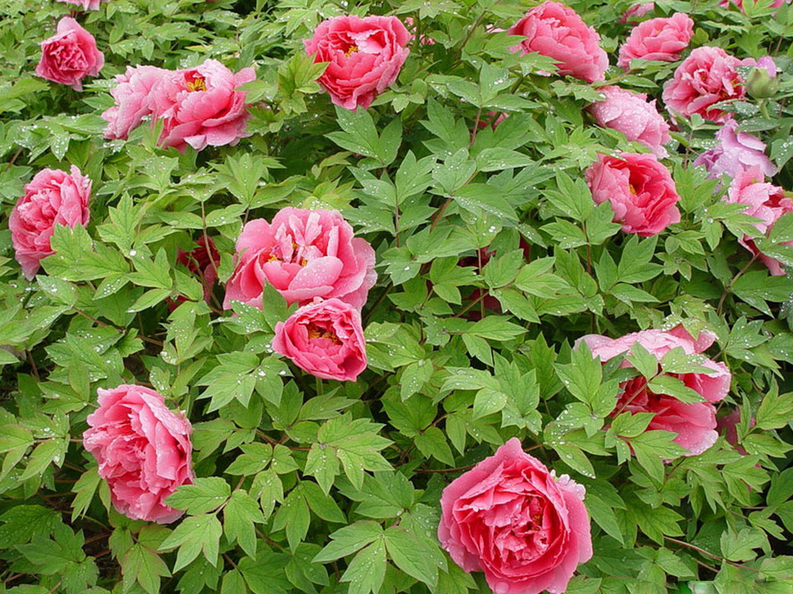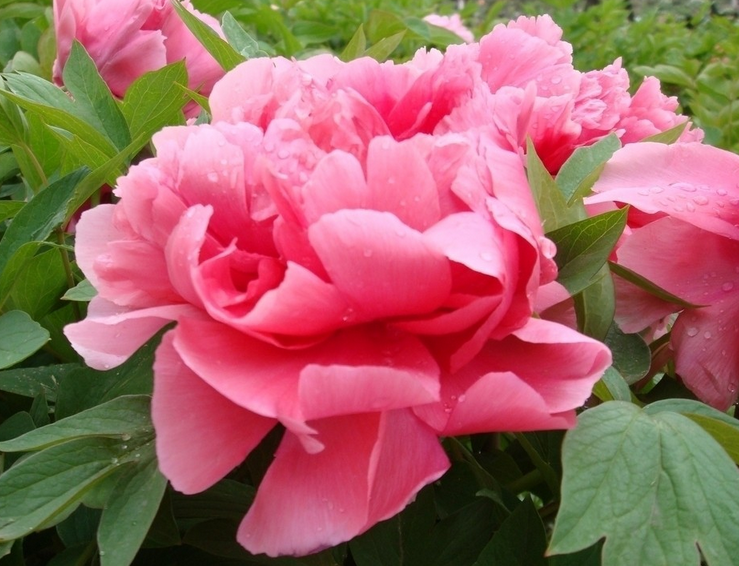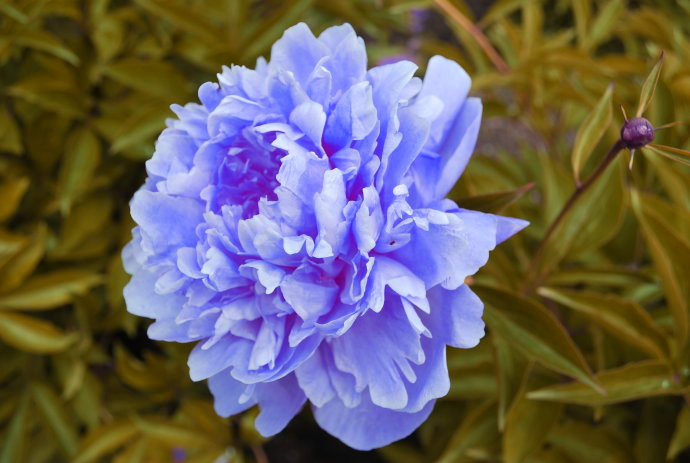The prevention and control of peony diseases and pests can help you cultivate peony flowers easily.
In the process of peony culture, peony flowers are often attacked by diseases and insect pests due to improper culture and other reasons. So the editor of the decoration network reminds you that when raising peonies, you must first master some relevant knowledge. Here, we will learn more about the prevention and control methods of peony diseases and insect pests with the decoration network editor.

The prevention and control of peony diseases and pests can help you cultivate peony flowers easily.
Control methods of Diseases and pests in Peony and Flower
I. Diseases
1. Brown spot: strengthen cultivation management and timely pruning to ensure ventilation and light transmission of plants so as not to get too wet and breed pathogens; timely cutting and burning of diseased leaves are found to reduce the source of infection. During the onset of the disease, 50% carbendazim wettable powder or 80% mancozeb wettable powder 1000 times or 80% mancozeb wettable powder 1000 times or 80% mancozeb wettable powder were sprayed every 10 to 15 days. The liquid should be sprayed evenly on the front and back of the leaves, and the effect was significant. Diseased leaves and diseased plants should be destroyed at the end of autumn, the nursery should be cleaned in winter, and then 7 to 10 times lime-sulfur mixture should be used to spray plant stems to kill pathogens.
2. Rust: select areas with high terrain and good drainage when planting peony; spray 160 times of Bordeaux solution before the disease, or spread 400 times of Dysen zinc around the plant; prevent and cure the disease with lime-sulfur mixture and strychnine; remove and burn the diseased plant in time.
3. Botrytis cinerea: remove diseased plants and burn to reduce the source of infection; crop rotation or deep ploughing is carried out in severe disease areas; attention should be paid to ventilation and light transmission during the growing season to enhance plant resistance; 0.1% equivalent Bordeaux solution is sprayed every 10 to 14 days at the initial stage of the disease, usually 3 to 4 times in a row.
4. Purple plume disease: choose dry, well-drained and loose soil to plant, apply rotten organic fertilizer; when discovering diseased plants, immediately remove the burning, or scrape off the rotten parts, then disinfect them with 4-5 degree lime-sulfur mixture or mercury, and replant. Disinfect the injured plants with lime or sulfur; at the initial stage of the disease, irrigate the roots of the diseased plants with 1000 times of desenamine, 500 to 1000 milliliters per plant, and cover the soil immediately after watering; when planting in autumn, the roots were soaked in 0.1% copper sulfate solution for 3 hours. then rinse with clean water before planting.
II. Insect pests
1. Cotton blowing shell beetles: strengthen plant quarantine and immediately eliminate pests. Gently brush off the harmful branches and leaves with soft brushes, or cut off harmful branches and leaves and burn them; spray fluoroacetamide during larval incubation, spray Baume 3-5 degrees lime-sulfur mixture during dormancy; protect and release natural enemies, such as Australian ladybug, red ladybug and so on.
2. Red spiders: weeding, fertilizing, eliminating overwintering eggs and reducing the initial harmful insect population; red spiders can be sprayed with 1000 times of 20% triclofenac wettable powder (which can be mixed with other acaricides) or 2000 times of 40% diclofenac emulsion, or 40% omethoate 1200 times to 1500 times. Such as killing eggs with Baume 0.3 degree stone sulfur mixture; protection and utilization of natural enemies, ladybugs, lacewings, thrips and so on.
3. Beetles: make use of its false death to kill adults artificially; kill them with sex attractants; spray 1000 times of liquid to oxidize dimethoate when the pest is serious.
4. Root nodule nematodes: this pest is an underground pest. When the damage is serious, rotation can be carried out, weeds in the nursery can be removed, and nematodes can be ploughed once a month, causing nematode death due to drought. 80% dibromopropane is sprayed, 1.5 kg per mu.
5. Mole cricket, ground tiger and grub: turn the nursery land in time, cultivate carefully, remove weeds in time, apply rotten organic fertilizer, irrigate the roots with omethoate 500 to 800 times, dig up the soil when the damaged stems and leaves are found, and artificially kill larvae or adults.
What are the common diseases and insect pests of peony and the control methods of common diseases and insect pests of tree peony
Peonies like warm, cool, dry and sunny environments. Like sunshine, but also resistant to semi-overcast, cold, drought, weak alkali, avoid stagnant water, afraid of heat, afraid of direct sunlight. Perhaps for those who often cultivate peonies, it is not difficult, but some of the peony diseases and insect pests may be at a loss, so what are the common peony diseases and insect pests? The following is to introduce the prevention and control methods of common peony diseases and insect pests.
What are the common diseases and insect pests of peony
The main diseases and insect pests of peony are: Botrytis cinerea, brown spot, anthracnose, ring spot, branch blight, root knot nematode disease.
1. Harm of Botrytis cinerea in peony.
Botrytis cinerea is one of the most important diseases of peony in the world, and it also occurs in China from time to time, especially in Shanghai, Zhengzhou and other places. The disease can occur in the growing season of tree peony and does serious harm to young plants, causing lodging and wilting of seedlings.
Control methods of Botrytis cinerea in peony
Method 1. To reduce the source of infection: remove the dead branches and leaves of the diseased plant in autumn, remove the diseased buds and leaves in spring, and bury the remains deeply.
Method 2. Chemical control in the growing season: once the disease occurs in the growing season, the following agents can be used for spray control: 1% lime equivalent Bordeaux solution, 70% methyl topiramate 1000-fold solution, 65% Dysen zinc 500-fold solution, or 50% clonitramine 1000-fold solution. Spray once every 10-15 days, 2-3 times in a row.
Method 3. Strengthen cultivation management: planting density should be moderate; drainage should be timely after rain, and wet soil should not be cultivated at the base of the plant clump; crop rotation should be carried out in seriously diseased areas; disease-free seedlings should be planted, and the seedlings can be soaked in 65% zinc 300 times solution for 10 minutes.
2. The harm of peony brown spot.
Brown spot, also known as red spot, is a common worldwide disease of peony. It often causes early withering of leaves and affects the growth potential of peony.
Control methods of Brown spot of Peony Flower
Method 1. Reduce the source of infection: thoroughly remove the disease residue on the ground in autumn; spray 50% carbendazim 600-fold solution or 3-degree stone-sulfur mixture before germination in early spring to kill the bacteria on the plant.
Method 2. Chemical control in the growing season: spray 50% carbendazim 1000 times solution, or 65% Dysen zinc 500 times solution, spray once in 7 days-10 days, 3-4 times successively.
Method 3. Strengthen cultivation management: moderate planting density, application of organic fertilizer and compound fertilizer.
3. The harm of anthracnose in peony flower.
Anthracnose is a common disease of peony in China. Anthracnose often causes peony leaves to suffer from withered spots, twisted stems and young branches to die.
Control methods of anthracnose in peony flower
Method 1. To reduce the source of infection, the method is the same as peony brown spot.
Method 2. Chemical control of the growing season: spray 70% anthrax 500 times solution, or 1% lime equivalent Bordeaux solution, or 65% Dysen zinc 500 times solution at the initial stage of the disease (May-June). 10-15 days once, a total of 2-3 times.
4. The harm of peony ring spot disease.
Wheel spot disease, also known as white star disease, is also a common leaf spot disease of peony, mainly harmful to leaves. When the disease occurred, the disease spot on the leaf was reticulate or nearly round, with a large number of 4~10mm in diameter, light brown to grayish white, and the edge was brown. The old disease spot had obvious gray-black mildew in the center of the disease spot, that is, the fruiting body of the pathogen.
Control of peony mosaic spot
Method 1. To reduce the source of infection: remove the fallen leaves of diseased plants in time and spray 3-degree stone-sulfur mixture before plant germination to kill the bacteria on tree peony plants.
Method 2. Chemical control during the growth period: spray 1% lime equivalent Bordeaux solution, or 50% acetaminophen 800 times solution, or 65% Dysen zinc 500 times solution. After the onset of the disease, the patients were sprayed continuously for 2-3 times (once a day for 10 days-15 days).
Method 3. Strengthen cultivation management: suitable planting density, good ventilation and light transmission.
5. Harm of peony branch blight
Peony branch blight infects the stems, branches and other parts of peony. The disease on the stem was a light brown spot, which gradually expanded to a reddish brown oval spot. The disease spot can circle the stem for a week, so that the branches above the disease spot die quickly.
In autumn, small black dots appear on the disease spot, which is the conidium of the pathogen. The buds became brown after infection, and the dead buds could remain on the plants for a long time. The disease is caused by fungi.
Disease conditions: pathogens mainly invaded from the wound. A large number of wounds and weak plant growth are conducive to the occurrence of diseases.
Control methods of peony branch blight
① strengthens cultivation management, enhances growth potential, reduces wounds, and improves disease resistance. ② chemical control: see peony brown spot.
6. harm of root-knot nematode disease in tree peony.
The occurrence of root-knot nematode disease in tree peony is common and has been reported at home and abroad. In the past 10 years, root-knot nematode disease has become the most important root disease of tree peony in China, causing early defoliation. When the disease was serious, the leaves of peony were all bare in August. It occurs year after year, with dwarf, small leaves, small flowers or no flowering on the plant.
Control methods of root-knot nematode disease in tree peony
Method 1. Strengthen quarantine to prevent the expansion of the epidemic area: when diseased vaccines are found in the introduction work, they must be treated: soak in 0.1% isophosphate for 30 minutes, or soak in warm water of 48 ℃-49 ℃ for 30 minutes.
Method 2. Chemical control in the field: 15% aldicarb granules were applied at acupoints, 5g-10g per plant, hole depth about 10cm. The drug was used in early May (Beijing), once a year.
Method 3. Pre-control method of disease: disinfect with heat or pesticide. Commonly used pesticides are bromane, aldicarb, clenophos and so on. The soil can also be dried and sterilized at high temperature, such as basin soil dried for 30 days (water content up to 0.17%) without nematode survival.
The cultivation method of how to plant peony flower
There are many flower-loving friends around us. Peony is one of our favorite varieties. How to plant peony? Next, let's tell you how to cultivate peonies.
1. Temperature and light
Sufficient sunlight is beneficial to the growth of peony, but it is not resistant to hot summer sun, and the plant will be dormant when the temperature is above 25 ℃. The suitable temperature for flowering is 17-20 ℃, but it must be treated with low temperature of 1-10 ℃ for 2-3 months before flowering. The minimum capacity is-30 ℃, but appropriate cold prevention measures should be taken in the northern cold zone in winter to avoid frost damage. The high temperature and humidity in the south is extremely disadvantageous to the growth of peonies, therefore, the cultivation of peonies in the south need to give them specific environmental conditions in order to enjoy the beautiful peony flowers.
2. Watering
Whether watering is proper or not is a key issue in the success or failure of potted peonies. After coming out of the house in early spring, apply fertilizer first, then pour water through, loosen the soil after water infiltration, and maintain the humidity of the basin soil until budding. If the pot is too dry, you can water it again until it blossoms. It is advisable to keep the basin soil moist in the future. On rainy days in summer, it is necessary to dump the stagnant water in the basin in time to prevent rotting roots.
3. Fertilization
Peony is a fertilizer-loving plant. In order to make the peony flowers big and colorful and avoid the phenomenon of "blooming every other year", we must pay attention to rational fertilization. The newly planted peony does not need to be fertilized within half a year, but can not be fertilized until half a year later. Generally speaking, fertilizer should be applied at least three times a year. The first time is "pre-flowering fertilizer", which is applied in combination with "thawing water" when the leaves and expenses are extended after the soil is thawed. For the second time, "post-anthesis fertilizer" was applied within half a month, and this fertilization played an important role in restoring plant growth and promoting flower bud differentiation. The third fertilizer was applied before the beginning of winter, and this fertilization played an important role in enhancing the growth in the coming spring. In the first and second fertilization, the fertilizer was made a living by quick-acting fertilizer, and the third fertilization was mainly based on slow-acting base fertilizer.
4. Pruning
In order to ensure the beautiful plant shape, luxuriant flowering and robust growth of peony, it also needs to be reshaped and pruned. Potted peony pruning can be divided into winter pruning and spring and summer pruning. In spring, the remaining buds of potted peony should be selected, the excess buds in the rhizosphere should be erased, the introverted branches, cross branches and heavy branches should be cut off, and the weak branches and excess branches should be removed to ensure that the plant shape is beautiful, ventilated and transparent. The residual flowers can be cut off in summer, and the diseased and dead branches can be cut off after falling leaves at the end of autumn.
5. Insect pests
The common disease of peony is brown spot, the leaves appear yellow-green spots at the beginning, and then gradually expand to form brown or black spots. Bordeaux liquid can be sprayed 1-2 times a month, if the condition is serious, it can be sprayed 3 times. The seriously infected leaves should be cut off and burned to prevent Cheyenne. There is also a kind of root rot that specifically harms the roots of peonies. The condition is that the roots blacken and rot, hindering growth, and serious ones can lead to the death of pruning. To prevent the disease, it is necessary to check carefully when planting ramets. If you find that there is a diseased root, you must cut off and burn it, and sprinkle some sulfur powder in the planting hole when planting. The common pest is cotton-blowing insect, which can be sprayed with 1500 times of omethoate emulsion and coated with stone-sulfur mixture in winter or early spring, which also has a good control effect.
- Prev

Analysis on the Culture methods of off-season Peony enjoy the four Seasons
Peonies usually bloom in April or May every year, but through people's breeding, peonies can also be in full bloom in off-season. So what should be done when raising peonies out of season? Are there any methods, tricks and tricks? Next, let's learn more about it with the editor of the decoration network.
- Next

Culture methods and matters needing attention of Paeonia lactiflora
Peony is known as "flower immortal" and "flower phase", and is listed as one of the "six famous flowers". It has been regarded as the flower of love since ancient times. Many people want to raise peony flowers on their own, so what should they do when raising peony flowers? Are there any methods and precautions?
Related
- Fuxing push coffee new agricultural production and marketing class: lack of small-scale processing plants
- Jujube rice field leisure farm deep ploughing Yilan for five years to create a space for organic food and play
- Nongyu Farm-A trial of organic papaya for brave women with advanced technology
- Four points for attention in the prevention and control of diseases and insect pests of edible fungi
- How to add nutrient solution to Edible Fungi
- Is there any good way to control edible fungus mites?
- Open Inoculation Technology of Edible Fungi
- Is there any clever way to use fertilizer for edible fungus in winter?
- What agents are used to kill the pathogens of edible fungi in the mushroom shed?
- Rapid drying of Edible Fungi

